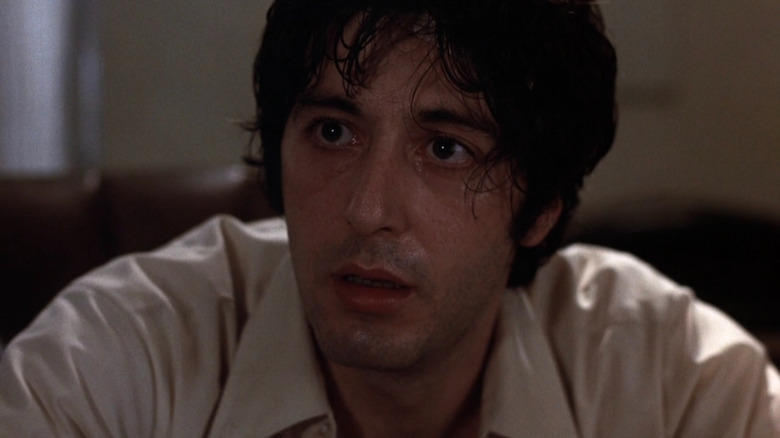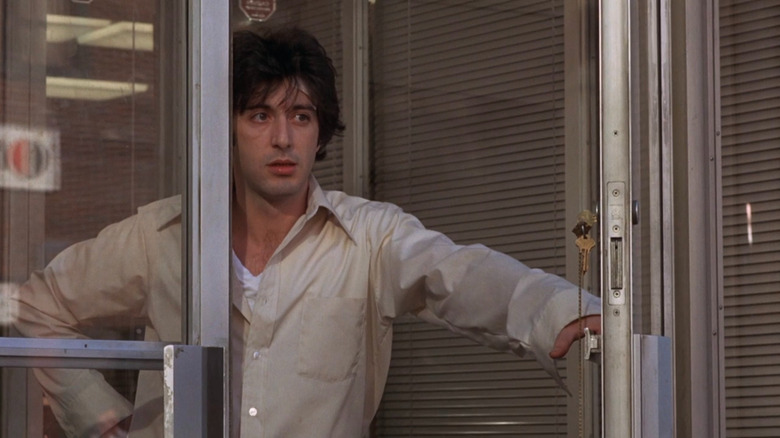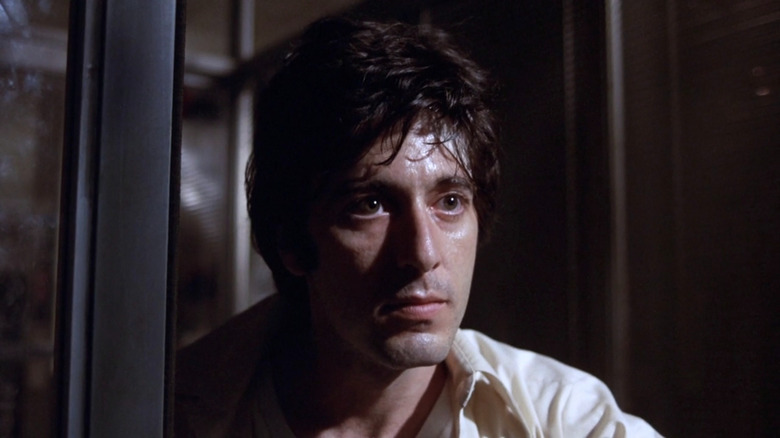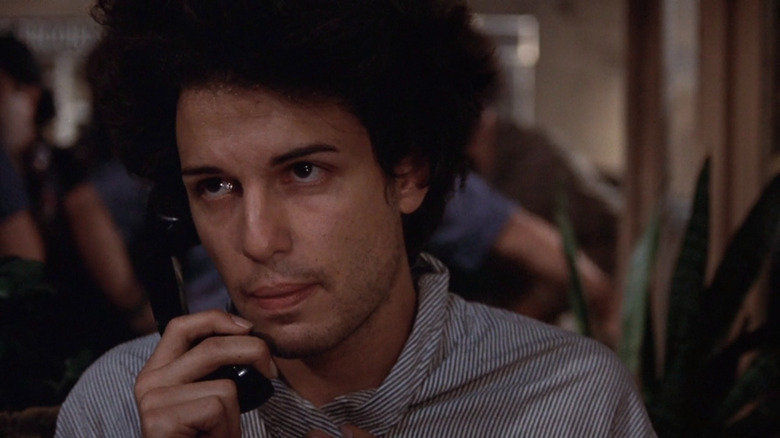Al Pacino's Dog Day Afternoon Doubts Manifested As A Mustache
They may not want to admit it, but men are absolutely obsessed with their own appearance. That obsession manifests itself in a litany of different ways. Sometimes, it is pure vanity. We all know those movie stars who wanted to be framed and lit a certain way to best accentuate their features, and they will only pick projects that will cater to upholding that specific appearance. Then, there's the extreme insecurity about looks, where you alter something about yourself because a feature of your body displeases you. Orson Welles famously hated how his nose looked and would typically wear a prosthetic noses in movies, even when nothing else about his appearance was different.
The more complicated version of this obsession is the blending of the two, and this is fairly unique to the acting profession. There are those actors who take great pride in the appearance they cultivated for themselves, but a script comes across their desk that they love but goes against that crafted persona. If that's the case, these men can go one of two ways: accept that their look could also fit this character or do something to drastically change their look and hide themselves. When "Dog Day Afternoon" came across the desk of Al Pacino, he chose the second option.
Now, you may be thinking, "Wait. Al Pacino just looks like Al Pacino in that movie." And you would be correct. However, that was not how he originally was going to approach the look of bank robber Sonny Wortzik. No, his initial inclination was to add some bristles above his upper lip.
'Comfort and solace' from a 'stache
Director Sidney Lumet was treated to quite a surprise when he showed on the first day of shooting "Dog Day Afternoon." There was something different about Al Pacino. He had a mustache on his face ... and Lumet and Pacino had not discussed this newly added facial hair prior to starting the movie. In the audio commentary for the film, Lumet says:
"He was nervous at the beginning of it and a great many actors find some source of security in makeup, it's as if they can hide behind something. In the beginning, Al — being nervous and being aware of the risk he was taking — was quite worried, so he thought maybe he could use a mustache. On the first day of shooting he turned up with a mustache, and I understood what was bothering him. I wasn't crazy about it but if he got some comfort and solace from it, and if it released him emotionally, that was fine with me because there was a bigger purpose at work here."
So, Lumet acquiesced, and Pacino got to have his mustache for a day. But a day was all it got. Lumet continues:
"He looked at himself at rushes the next day, and he looked at me and said, 'It's wrong, isn't it?' and I said, 'It's wrong, Al,' so he got rid of it and we re-shot the first day's work."
This was not a mustache that came from a natural place for the character. This was a mustache born out of pure insecurity. At first glance, it could be difficult to pinpoint why he was so nervous about taking on this part with just his own face. But you have to remember it was 1975.
Why was Pacino so worried?
Nothing rattles the straight male ego more than the idea that someone might perceive you as gay. It is a destructive internalized homophobia that still runs rampant today. Maybe not as bad as in 1975 when this film was being made, but it's still common. Some men can have the perfectly normal mindset of accepting and loving gay people in their lives, but the idea that they might accidentally be thought of us being attracted to men puts them on their crazy defensive side.
This insecurity is what birthed Al Pacino's mustache. As Sidney Lumet put it:
"He was now a big star. 'Godfather' 1 and 2 had happened, and after those performances — the macho, controlled, ice-cold person in those movies — to suddenly play a homosexual in love with another man, and for whom this whole wild experience is something that's so alien to most of our lives, to take that risk was enormous."
I wish we didn't live in a world where people worried about things that should be trivial, but unfortunately, we do not. A man with that persona does not want to be feminized in any way. But that insecurity does not just come from a vanity perspective, but a business one as well. Playing a gay character could really hurt your career as an actor, as there is this weird belief that people would not believe you as a character who isn't gay afterwards. As "Dog Day Afternoon" proved, ultimately, nobody perceived Al Pacino as gay, and his career went swimmingly.
He was in love with a trans woman, not a man
Now, I don't want to quibble with Sidney Lumet. He is one of the greatest filmmakers ever. But ... I have to. Al Pacino's character Sonny Wortzik in "Dog Day Afternoon" was not "in love with another man," as Lumet said. Sonny was in love with a transgender woman. I am not inferring. I am not imposing modern views onto an older film. Leon, played by Chris Sarandon, is a trans woman. She explicitly states in the film that she is "a woman trapped in a man's body," and the whole reason behind the bank robbery than Sonny and his partner Sal (John Cazale) are committing is to fund Leon's gender affirmation surgery. John Wojtowicz served as the inspiration for Sonny, and according to the New York Times, he used the part of the profits he made off of "Dog Day Afternoon" to actually finance the surgery for his real life partner Elizabeth Eden, the basis for Sarandon's Leon. I'm not saying that Wojtoicz was not gay or bisexual, but this was not a homosexual relationship.
So, there's even some transphobia mixed in with the homophobia. Of course, in 1975, most people barely had a grasp on the very concept of a trans person. But even today, this is yet another thing so many people need to get through their heads. Trans women are women, not men. And to my fellow cishet guys: it is perfectly okay to be attracted to them. You aren't gay if you do. But that is not something you need to be worried about anyway!



